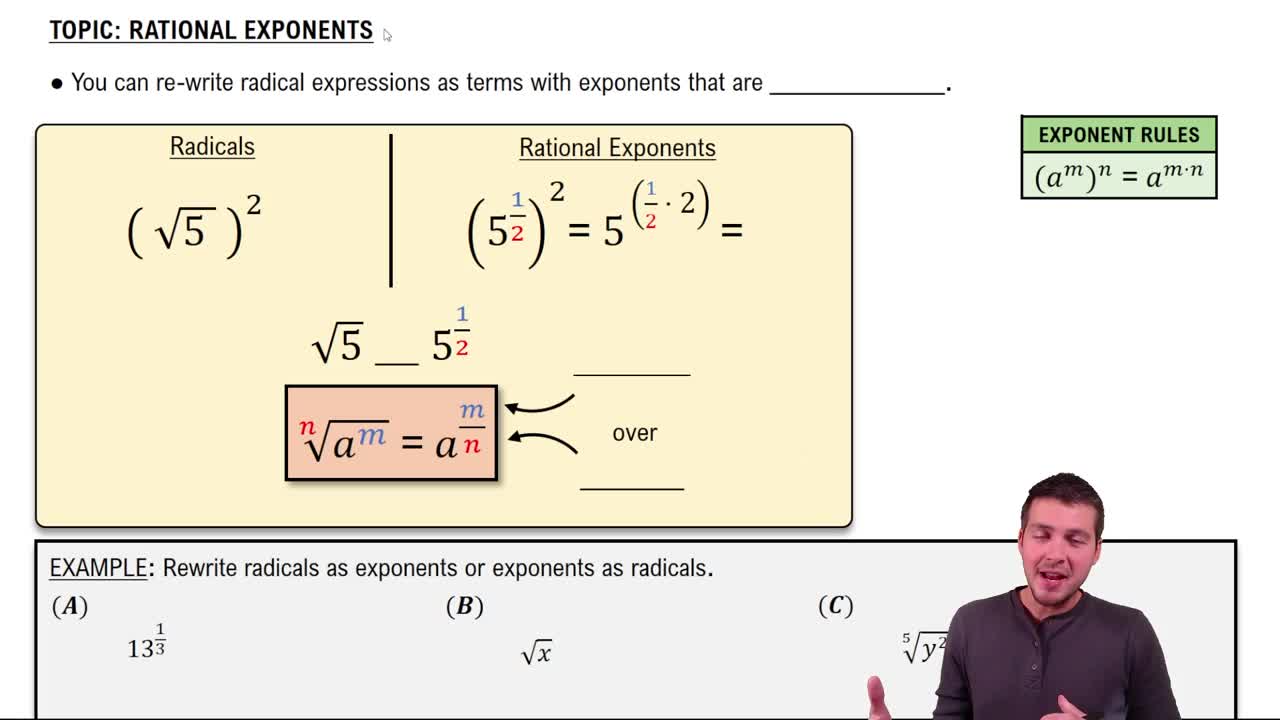Table of contents
- 0. Review of Algebra4h 16m
- 1. Equations & Inequalities3h 18m
- 2. Graphs of Equations43m
- 3. Functions2h 17m
- 4. Polynomial Functions1h 44m
- 5. Rational Functions1h 23m
- 6. Exponential & Logarithmic Functions2h 28m
- 7. Systems of Equations & Matrices4h 6m
- 8. Conic Sections2h 23m
- 9. Sequences, Series, & Induction1h 19m
- 10. Combinatorics & Probability1h 45m
0. Review of Algebra
Exponents
Problem 86c
Textbook Question
Evaluate each expression. (-2)^5
 Verified step by step guidance
Verified step by step guidance1
Identify the base and the exponent in the expression \((-2)^5\). Here, the base is \(-2\) and the exponent is \(5\).
Understand that the exponent \(5\) indicates that the base \(-2\) should be multiplied by itself a total of 5 times.
Write out the multiplication: \((-2) \times (-2) \times (-2) \times (-2) \times (-2)\).
Calculate the product step by step, starting with the first two numbers: \((-2) \times (-2) = 4\).
Continue multiplying the result by the next \(-2\) until all factors are used: \(4 \times (-2)\), then \(-8 \times (-2)\), and so on.
Recommended similar problem, with video answer:
 Verified Solution
Verified SolutionThis video solution was recommended by our tutors as helpful for the problem above
Video duration:
1mPlay a video:
Was this helpful?
Key Concepts
Here are the essential concepts you must grasp in order to answer the question correctly.
Exponents
Exponents represent the number of times a base is multiplied by itself. In the expression (-2)^5, the base is -2, and the exponent is 5, indicating that -2 should be multiplied by itself five times. Understanding how to apply exponents is crucial for evaluating expressions involving powers.
Recommended video:
Guided course

Rational Exponents
Negative Numbers
Negative numbers are values less than zero, and they can affect the outcome of mathematical operations, especially when raised to an exponent. In this case, raising a negative number to an odd exponent results in a negative product, which is essential to remember when evaluating expressions like (-2)^5.
Recommended video:

Square Roots of Negative Numbers
Order of Operations
The order of operations is a set of rules that dictates the sequence in which mathematical operations should be performed to ensure consistent results. When evaluating expressions, it is important to follow these rules, particularly when dealing with exponents, multiplication, and addition, to arrive at the correct answer.
Recommended video:
Guided course

Performing Row Operations on Matrices

 7:39m
7:39mWatch next
Master Introduction to Exponent Rules with a bite sized video explanation from Patrick Ford
Start learningRelated Videos
Related Practice













